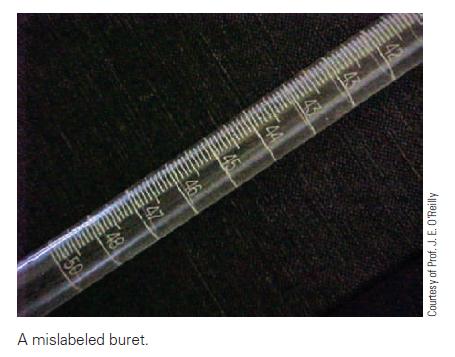This photo shows a buret that has at least two defects on the scale that were created
Question:
This photo shows a buret that has at least two defects on the scale that were created during its fabrication.

Answer the following questions about the buret, its origin, and its use.
(a) Under what conditions is the buret usable?
(b) Assuming that the user does not notice the defects in the buret, what type of error would occur if the liquid level was between the second 43-mL mark and the 48-mL mark?
(c) Assume that the initial reading in a titration is 0.00 mL (very unlikely), and calculate the relative error in the volume if the final reading is 43.00 (upper mark). What is the relative error if the same reading is made on the lower mark? Perform the same calculation for a final reading made at the 48.00-mL mark. What do these calculations demonstrate about the type of error caused by the defect in the buret?
(d) Speculate on the age of the buret. How would you suspect that the markings were made on the glass? Is it likely that the same type of defect would appear on a buret manufactured today? Explain the rationale for your answer.
(e) Modern electronic chemical instruments such as pH meters, balances, titrators, and spectrophotometers are normally assumed to be free of manufacturing defects analogous to the one illustrated in the photo. Comment on the wisdom of making such an assumption.
(f ) Burets in automated titrators contain a motor connected to a screw-driven plunger that delivers titrant in much the same way that a hypodermic syringe delivers liquids. The distance of travel of the plunger is proportional to the volume of liquid delivered. What kinds of manufacturer’s defects would lead to inaccuracy or imprecision in the volume dispensed by these devices?
(g) What steps can you take to avoid measurement errors while using modern chemical instruments?
Step by Step Answer:

Fundamentals Of Analytical Chemistry
ISBN: 9780357450390
10th Edition
Authors: Douglas A. Skoog, Donald M. West, F. James Holler, Stanley R. Crouch





